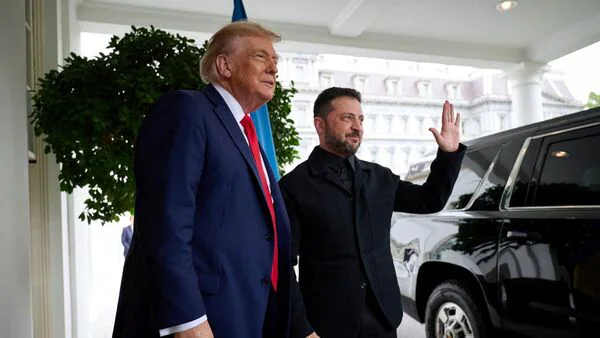White House Press Secretary Karoline Leavitt has confirmed that the United States will not deploy ground troops to Ukraine as part of any security guarantees, emphasizing coordination with European allies and alternative support measures. This statement, made during a press briefing, aligns with President Donald Trump’s broader push for peace negotiations to end the Russia-Ukraine conflict. The announcement follows high-level talks with Ukrainian President Volodymyr Zelensky and European leaders, amid discussions of a potential peace deal and security frameworks for Ukraine. This article examines the context, implications, challenges, and opportunities surrounding the U.S. stance, drawing on recent developments and public sentiment.
Details of the White House Statement
Press Briefing Highlights
-
No Ground Troops: Leavitt explicitly stated that President Trump has ruled out sending U.S. troops to Ukraine, saying, “The president has definitively stated US boots will not be on the ground in Ukraine.” Instead, the U.S. will focus on coordination and “other means of security guarantees” for European allies.
-
Alternative Support: When pressed on potential U.S. involvement, Leavitt noted that air support remains a possibility, with Trump directing his national security team to develop a framework for lasting peace. This includes coordinating with Europe and engaging with both Ukraine and Russia.
-
Economic Considerations: Leavitt highlighted Trump’s sensitivity to American taxpayers, proposing that NATO purchase U.S. weaponry to support Ukraine, avoiding direct financial aid and ensuring economic benefits for the U.S. defense industry.
Context of the Announcement
-
Recent Talks: The statement follows Trump’s meetings with Zelensky, European leaders (including France’s Emmanuel Macron, Germany’s Friedrich Merz, and the UK’s Keir Starmer), and a call with Russian President Vladimir Putin. These discussions, held at the White House, focused on security guarantees to prevent future Russian aggression.
-
Peace Negotiations: Trump’s push for a Russia-Ukraine peace deal, including a proposed meeting between Putin and Zelensky, underscores the U.S. commitment to diplomacy. Leavitt credited Trump with facilitating direct talks between the two nations for the first time in years.
Strategic Implications
U.S. Foreign Policy
-
Limited Military Involvement: The decision to avoid ground troops reflects a continuation of U.S. policy since 2022, when President Joe Biden also ruled out combat forces in Ukraine to prevent escalation with nuclear-armed Russia. This aligns with Trump’s “America First” approach, prioritizing domestic resources.
-
European Responsibility: Trump emphasized that European nations, such as France, Germany, and the UK, may deploy troops to Ukraine as part of a peacekeeping or deterrent force, with the U.S. providing logistical or air support.
Global Security Dynamics
-
NATO and European Role: The U.S. stance shifts the burden to European allies, with reports indicating that up to 30 countries, including France and the UK, are considering contributing to a “coalition of the willing” for Ukraine’s security. However, Russia’s opposition to NATO troops in Ukraine complicates implementation.
-
Russia’s Response: Russian Foreign Ministry spokesperson Maria Zakharova called NATO troop deployment “categorically unacceptable,” while Foreign Minister Sergei Lavrov left open the possibility of Putin-Zelensky talks, suggesting cautious engagement.
Challenges
Security Guarantees
-
Ambiguity in Framework: The lack of clarity on “other means of security guarantees” raises questions about their effectiveness. Analysts note that a credible deterrent force, potentially requiring 10,000–40,000 troops, faces logistical and political hurdles, as per the International Institute for Strategic Studies.
-
Russian Veto: Russia’s insistence on limiting Ukraine’s military capabilities and excluding NATO forces could stall negotiations, as Moscow views such deployments as escalatory.
Domestic and International Pushback
-
U.S. Public Opinion: Polls, like a 2022 AP-NORC survey, show only 26% of Americans support a major U.S. role in Ukraine, complicating Trump’s push for even non-combat support like air operations.
-
European Dependency: European militaries rely on U.S. logistics, airlift, and intelligence, meaning any European-led force in Ukraine would still require American involvement, potentially undermining the “no boots” pledge.
Geopolitical Risks
-
NATO Credibility: If Russia violates a ceasefire and attacks a European force in Ukraine, U.S. inaction could weaken NATO’s credibility, as warned by a 2025 RAND report.
-
China’s Influence: The U.S. focus on Ukraine coincides with tensions over China’s Belt and Road Initiative, as seen in Afghanistan’s recent engagement, potentially diverting attention from Asia-Pacific priorities.
Opportunities
Diplomatic Progress
-
Peace Negotiations: Trump’s facilitation of Russia-Ukraine talks, including a potential Putin-Zelensky meeting, could lead to a ceasefire, reducing the conflict’s toll, which Trump cited as causing 5,000–7,000 weekly casualties.
-
Strengthened Alliances: Coordinating with European allies on security guarantees could reinforce NATO unity, with countries like Poland and the Baltics expressing willingness to contribute.
Economic Benefits
-
Defense Industry Gains: Trump’s proposal for NATO to purchase U.S. weapons could boost American manufacturers, with the global arms market projected to grow 5% by 2030, per industry estimates.
-
Energy Market Stability: A successful peace deal could stabilize global energy markets, impacted by the Russia-Ukraine conflict, benefiting U.S. consumers facing high gasoline prices.
Global Leadership
-
U.S. Diplomatic Leverage: Trump’s claim of brokering peace in seven global conflicts, including Ukraine, enhances U.S. influence, potentially countering China’s growing role in regions like Afghanistan.
-
Model for Conflict Resolution: A successful Ukraine strategy could serve as a blueprint for resolving other conflicts, aligning with U.S. interests in maintaining global stability.



